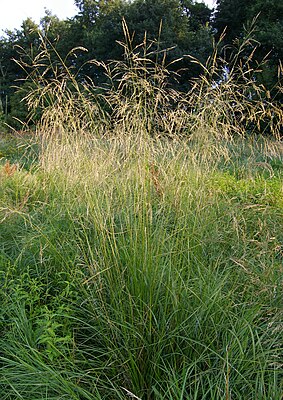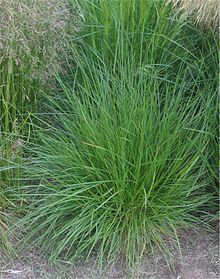Lawn Schmiele
| Lawn Schmiele | ||||||||||||
|---|---|---|---|---|---|---|---|---|---|---|---|---|

Lawn Schmiele ( Deschampsia cespitosa ) |
||||||||||||
| Systematics | ||||||||||||
|
||||||||||||
| Scientific name | ||||||||||||
| Deschampsia cespitosa | ||||||||||||
| ( L. ) P.Beauv. |
The turf Schmiele ( Deschampsia cespitosa ) is a plant species within the sweet grass family (Poaceae). It is widespread in the temperate to arctic regions of Eurasia and North America .
description
Appearance and leaf
The lawn Schmiele is a hibernating green, perennial herbaceous plant and reaches heights of usually 30 to 150, rarely up to 200 centimeters. Through the formation of numerous renewal shoots that grow up within the lowest leaf sheaths, it attains a dense growth and forms dense, coarse clumps .
The alternate leaves arranged on the stalks are divided into leaf sheath and leaf blade. The leaf sheaths are hairless. The long, flat leaf blades are remarkably rough on top and smooth on the underside. The leaf blades have a characteristic seven to eleven parallel-ribbed structure. The ligule is clearly defined as a 6 to 8 millimeter long, membranous border.
Inflorescence, flower and fruit
The flowering period in Central Europe extends from June to August. The pyramidal, paniculate inflorescence is up to 50 centimeters long and up to 20 centimeters wide. The panicle branches feel rough. The individual, two-flowered spikelets are only 4 to 5 millimeters long and are never transformed into brood buds .
The upper, three-veined glume is 3 to 4 millimeters long, lanceolate and tapering. The lower glume is only one-nerved. The awn generally does not rise above the five-veined, 3 to 4 millimeter long, elongated-elliptical lemma. The palea are as long as the lemma. The anthers are about 1 to 2 millimeters long.
The caryopsis is about 2 millimeters long.
The number of chromosomes is 2n = 26, 28, 52 or 56.
ecology
The lawn Schmiele is a hemicryptophyte and a clump grass. The plant has roots up to 1 m deep. The vegetative propagation takes place through underground runners . The stomata are located in the gutters in between, and they are protected by a slight curling of the leaf when it is dry. The ribs are rough backwards, which probably serves as protection against eating.
In terms of flower ecology, it is wind flowering according to the "long-dust thread type".
Diasporas (expansion units) are covered by the cover and pre furs caryopses . The spelled fruits formed in this way are relatively light and are subject to the spread of wind as a wind scatterer or as a balloon flyer or to the spread through water as a rainwater or a floating fruit. Because of the long, knee-shaped and hygroscopic awn , they can stick to the fur of animals and spread themselves on the damp ground by jumping movements. In addition, there is the chance spread through eating ungulates . The caryopses are light germs . Fruit ripening is from August to October.
Occurrence and grazing
The range of the Rasen-Schmiele covers large parts of the temperate to arctic zones of Europe and Asia as well as North America. But it probably wasn't originally native to America. Within mountain regions, it is even found in the tropics of Africa and Asia, as well as in Australia ( Tasmania ) and New Zealand.
The lawn Schmiele is widespread from the plains to alpine altitudes . It inhabits moist to wet meadows, pastures and swamps. There are secondary occurrences in humid, sparse deciduous forests and in spring corridors. This demanding grass prefers mild to moderately acidic, humus-rich, nutrient-rich loam or clay soils . Lawn Schmiele is a characteristic of the wet meadows (Molinietalia caeruleae) and is also a companion species of the spring herb communities (Montio-Cardaminetalia). It is also found in societies of deciduous deciduous forests (Querco-Fagetea). You can also call them socially vague.
Lawn Schmiele is commonly referred to as cutting grass due to its sharp, rough leaves. It is avoided by cattle because of this characteristic. In meadows and pastures, the lawn Schmiele is considered to inhibit rejuvenation, on the other hand, it promotes silting processes on water banks .
Subspecies
In Deschampsia cespitosa (L.) P.Beauv. the following subspecies are distinguished:
- Deschampsia cespitosa subsp. cespitosa (Syn .: Deschampsia cespitosa subsp. alpina (L.) Tzvelev ; Deschampsia cespitosa subsp. beringensis (Hultén) WELawr .; Deschampsia cespitosa subsp. borealis (Trautv.) Tzvelev ; Deschampsia cespitosa subsp. brevifolia (R.Br.) Tzvelev ; Deschampsia cespitosa subsp. Obensis (Roshev.) Tzvelev ; Deschampsia cespitosa subsp. Orientalis Hultén ): It is widespread in the subarctic and temperate zones of the earth up to the mountains of the tropics.
- Deschampsia cespitosa subsp. holciformis (J.Presl) WELawr. : It occurs in western North America.
- Deschampsia cespitosa subsp. levis (Takeda) Nosaka : It is endemic to the Yubari Mountains in northern Japan.
- Deschampsia cespitosa subsp. macrothyrsa (Tatew. & Ohwi) Tzvelev : It occurs from the Far Eastern Russian East Asia to northern Japan.
- Deschampsia cespitosa subsp. mezensis (Senjan.-Korcz. & Korcz.) Tzvelev : It occurs in northern European Russia.
- Schlamm-Schmiele ( Deschampsia cespitosa subsp. Paludosa (Schübl. & G.Martens) GCSClarke ; Syn .: Deschampsia wibeliana (Sond.) Parl. ): It occurs only in northwestern Germany; it is endemic to the tidal area of the Elbe and Eider. Their chromosome number is 2n = 26.
- Deschampsia cespitosa subsp. pamirica (Roshev.) Tzvelev : Your homeland is Central Asia.
- Deschampsia cespitosa subsp. parviflora (Thuill.) Dumort. : It occurs from Europe to the Caucasus.
- Deschampsia cespitosa subsp. septentrionalis Chiapella (Syn .: Deschampsia brevifolia R.Br. ): This species, described by Robert Brown in 1824, was classified as a subspecies under a new name in 2016. It occurs in sub-arctic America.
- Deschampsia cespitosa subsp. sikkimensis Noltie : It occurs from Tibet to Sikkim.
- Deschampsia cespitosa subsp. wilhelmsii (Steud.) Tzvelev : It occurs from Turkey to the Caucasus.
Common names
The following names are also used as other German-language trivial names, sometimes only regionally: Field sedge, field ostrich grass, Glanzschmelen ( Silesia ), Leethardel, Rabinen, Rabissgras, Rasenschmelen (Silesia), Schmäle ( Lucerne , Basel ), Schmalm ( Bavaria ), Schmelchen (Bavaria), Schmele ( Austria , Bavaria, Schwaben , Wetterau ), die Schmeler (Austria), Schmelle (Swabia), Schmiele (Silesia, Swabia), Schmillen ( Transylvania ), Schmöllen ( Salzungen ), Schmolme ( Coburg ), Scholtgras ( Oldenburg), Smele (Göttingen), Smelhe ( Middle High German ), Smelohe ( Old High German ) and Straussgras (Silesia).
literature
- Dietmar Aichele, Heinz-Werner Schwegler: Our grasses. Sweet grasses, sour grasses, rushes . 11th edition. Kosmos, Stuttgart 1998, ISBN 3-440-07613-X .
- Hans Joachim Conert: Parey's grass book. Recognize and determine the grasses of Germany . Parey, Berlin 2000, ISBN 3-8263-3327-6 .
- Charles Edward Hubbard: Grasses. Description, distribution, use (= UTB . Volume 233 ). 2nd, revised and expanded edition. Eugen Ulmer, Stuttgart (Hohenheim) 1985, ISBN 3-8001-2537-4 (English: Grasses . Translated by Peter Boeker).
- Eckehart J. Jäger, Klaus Werner (Ed.): Excursion flora from Germany . Founded by Werner Rothmaler. 10th edited edition. tape 4 : Vascular Plants: Critical Volume . Elsevier, Spektrum Akademischer Verlag, Munich / Heidelberg 2005, ISBN 3-8274-1496-2 .
- Ruprecht Düll , Herfried Kutzelnigg : Pocket dictionary of plants in Germany and neighboring countries. The most common Central European species in portrait. 7th, corrected and enlarged edition. Quelle & Meyer, Wiebelsheim 2011, ISBN 978-3-494-01424-1 (Ecology section).
Individual evidence
- ↑ a b c Lawn Schmiele. In: FloraWeb.de.
- ↑ a b c Erich Oberdorfer : Plant-sociological excursion flora for Germany and neighboring areas . 8th edition. Verlag Eugen Ulmer, Stuttgart 2001, ISBN 3-8001-3131-5 . Page 242.
- ^ Deschampsia cespitosa in the Germplasm Resources Information Network (GRIN), USDA , ARS , National Genetic Resources Program. National Germplasm Resources Laboratory, Beltsville, Maryland. Retrieved January 3, 2007.
- ↑ a b c d e f g h i j k l Rafaël Govaerts (ed.): Deschamppsia cespitosa. In: World Checklist of Selected Plant Families (WCSP) - The Board of Trustees of the Royal Botanic Gardens, Kew . Retrieved August 29, 2018.
- ^ Georg August Pritzel , Carl Jessen : The German folk names of plants. New contribution to the German linguistic treasure. Philipp Cohen, Hannover 1882, page 52, online.
Web links
- Deschampsia cespitosa (L.) P. Beauv. s. str., lawn Schmiele. In: FloraWeb.de.
- Lawn Schmiele . In: BiolFlor, the database of biological-ecological characteristics of the flora of Germany.
- Profile and distribution map for Bavaria . In: Botanical Information Hub of Bavaria .
- Deschampsia cespitosa (L.) P. Beauv. In: Info Flora , the national data and information center for Swiss flora . Retrieved September 28, 2015.
- Thomas Meyer: Data sheet with identification key and photos at Flora-de: Flora von Deutschland (old name of the website: Flowers in Swabia )
- Michael Hassler, Bernd Schmitt: Data sheet: Deschampsia cespitosa ssp. cespitosa (L.) P. Beauv (Rasen-Schmiele) at Flora von Deutschland - A picture database , version 2.91.
- Distribution in the northern hemisphere from: Eric Hultén, Magnus Fries: Atlas of North European vascular plants. 1986, ISBN 3-87429-263-0 at Den virtuella floran.



